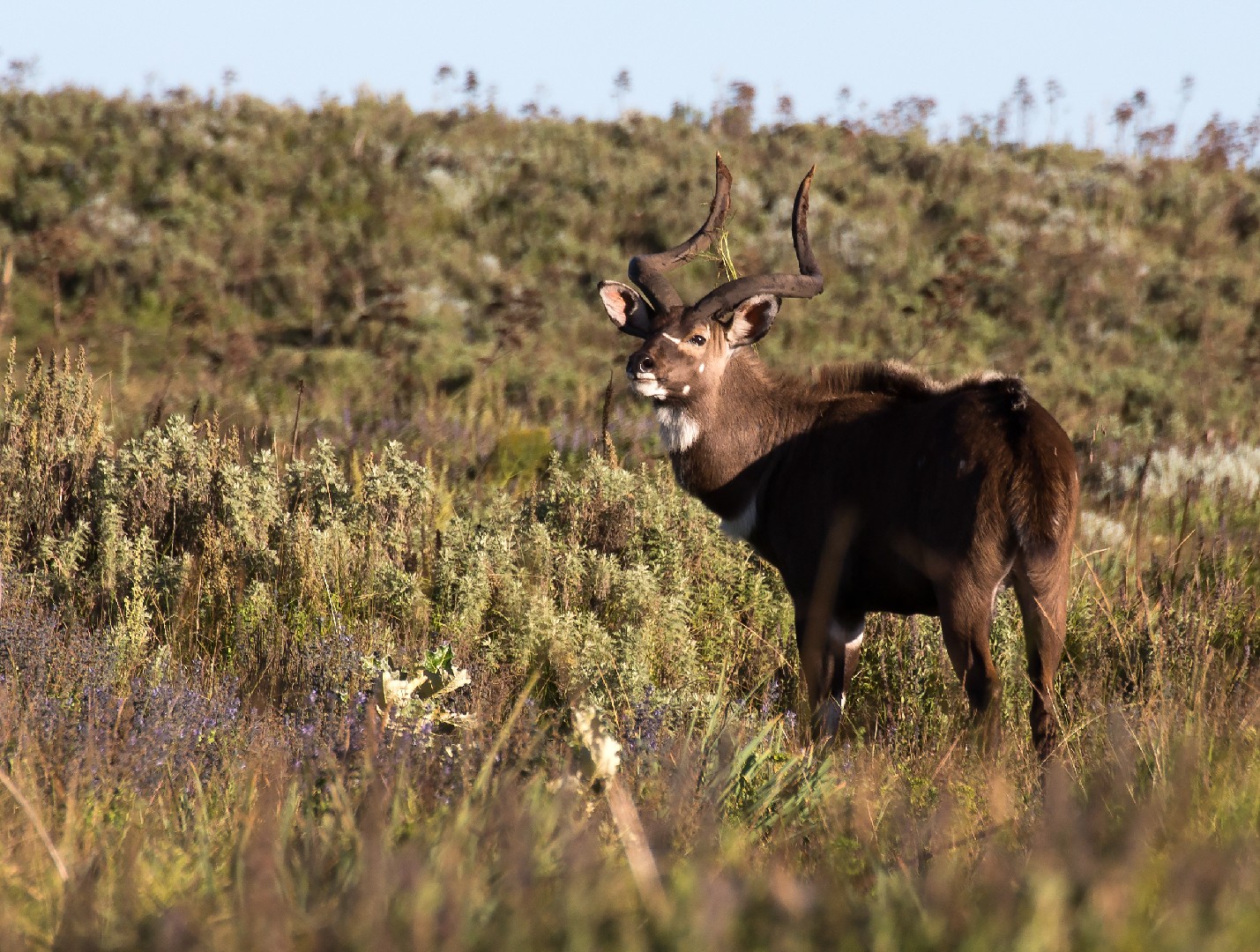Mountain nyala
A species of Elands Scientific name : Tragelaphus buxtoni Genus : Elands
Mountain nyala, A species of Elands
Scientific name: Tragelaphus buxtoni
Genus: Elands
Content
Description General Info
 Photo By user:dcastor , used under CC0 /Cropped and compressed from original
Photo By user:dcastor , used under CC0 /Cropped and compressed from original Description
The mountain nyala is a large sexually dimorphic bovid. The head-and-body length is approximately 240–260 cm (94–102 in) in males and 190–200 cm (75–79 in) in females. The males are typically 120–135 cm (47–53 in) tall while females stand 90–100 cm (35–39 in) at the shoulder. Males weigh 180–300 kg (400–660 lb) and females weigh 150–200 kg (330–440 lb). The bushy tail reaches the heel, and is 20–25 cm (7.9–9.8 in) long. The sensitive ears are large and lined with white hair. The coat is grey to brown, marked with two to five poorly defined white strips extending from the back to the underside, and a row of six to ten white spots. White markings are present on the face, throat and legs as well. The white chevron between the eyes and the white patch on the throat are among the most conspicuous markings. The chest and the rump are white. The lower part of the legs are pale on the inside and clear white spots are present just above the hooves. The coat is fawn brown in male juveniles, and grows darker with age, eventually becoming charcoal in old bulls. Males have a short dark erect crest, about 10 cm (3.9 in) high, running along the middle of the back, from the neck to the tail. Coat texture may vary from smooth to rough, probably by season. Females resemble the red deer hind in size and proportions. Female juveniles are a bright rufous, and old females are as grey as young males. Females have two pairs of inguinal nipples. Only males possess horns, whose maximum recorded length is 188 cm (74 in). Horns appear as cream-coloured nubs at around six months and start growing in a spiral pattern, reaching full growth by two years. The horns have only one or two spirals, though a few males have been reported to have two-and-a-half turns. The final form might vary in different males – the horns could form well-defined spirals, or could diverge in a structure similar to a lyre, resembling the horns of an impala, but with the final spiral incomplete. Growth rings are visible on the horn sheaths, but the annual patterns might be difficult to comprehend. Though the horns might wear out with age, the cream colour of the tips persists. The mountain nyala resembles the greater kudu in that both have an array of white spots along their flanks and possess spiral horns. However, the greater kudu can be told apart from the mountain nyala due to the former's greater height and paler colour. Moreover, the horns in greater kudu have two to three spirals, and the tips are farther apart. Another species similar to the mountain nyala is the nyala, but the latter can be easily distinguished from the former due to its smaller size and a fringe of long hair along its throat and neck. The horns of nyala, though very similar, are slender and narrower. 
General Info
Lifespan
12-15 years
Appearance
Mountain nyala is a medium-sized antelope with a sleek, muscular build and dense, shaggy fur. The coat is predominantly dark brown with distinctive white markings on its face and legs. Mature males possess long, spiral horns. Youth are lighter in color, becoming darker and more marked with age. Females have no horns and are slightly smaller than males.
Behavior
Mountain nyala is a nocturnal and elusive herbivore, typically solitary, with cross-gender interactions mainly during mating season. The species is notable for its distinctive 'knee-clicking' sounds and markings to claim territory. Adapted to montane environments, it exhibits excellent climbing abilities.
Population
Decreasing